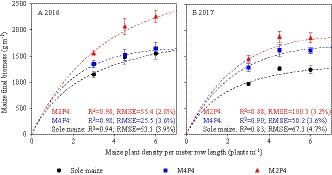当前位置:
X-MOL 学术
›
Food Energy Secur.
›
论文详情
Our official English website, www.x-mol.net, welcomes your
feedback! (Note: you will need to create a separate account there.)
Does reduced intraspecific competition of the dominant species in intercrops allow for a higher population density?
Food and Energy Security ( IF 4.0 ) Pub Date : 2021-01-26 , DOI: 10.1002/fes3.270 Qi Wang 1, 2, 3 , Wei Bai 4 , Zhanxiang Sun 4 , Dongsheng Zhang 5 , Yue Zhang 2 , Ruonan Wang 2 , Jochem B. Evers 3 , Tjeerd‐Jan Stomph 3 , Wopke Werf 3 , Chen Feng 4 , Lizhen Zhang 2
Food and Energy Security ( IF 4.0 ) Pub Date : 2021-01-26 , DOI: 10.1002/fes3.270 Qi Wang 1, 2, 3 , Wei Bai 4 , Zhanxiang Sun 4 , Dongsheng Zhang 5 , Yue Zhang 2 , Ruonan Wang 2 , Jochem B. Evers 3 , Tjeerd‐Jan Stomph 3 , Wopke Werf 3 , Chen Feng 4 , Lizhen Zhang 2
Affiliation

|
Dominant species in intercropping experience less resource competition compared with its monoculture. This reduced competition for resources may allow cultivating the dominant species at an increased density in intercropping to obtain greater yield. However, experimental results are inconclusive when the optimal within row density in the sole crop is not well established. Here, we conducted a two‐year experiment to test the hypothesis that optimal within row plant density of dominant species in intercropping would be higher in the intercrop than in the sole crop. We tested three maize densities (3, 4.5, and 6 plants m−1) in both sole maize and two replacement designed intercrops. The row configurations of two intercrops are two rows maize intercropped with four rows peanut (M2P4) and four rows maize intercropped with four rows peanut (M4P4). Peanut was grown at the same plant density of 12 plants m−1 row in both sole crop and intercrops. The results indicated that increasing maize density from the optimal density in monoculture is not worthy of promotion to improve yield in intercropping, which denied our hypothesis. The land equivalent ratios (LER) in the dry year (2017) were higher than the wet year (2016). Maize yields per unit area of the whole intercropping system were highest with densities of 4.5 and 6 plants m−1 row, with no significant difference between these two densities. Maximum maize yields in sole cropping were obtained with maize densities of 6 plants m−1 row. Intercropping provided higher yields at low and intermediate sole crop maize densities, but not at high sole crop maize density. Average land equivalent ratios at 3, 4.5, and 6 plants m−1 of maize were 1.09, 1.04, and 0.95 in 2016, and 1.07, 1.10, and 1.02 in 2017. Our results suggest that intercropping performs better at conditions with less resources than adequate resources.
中文翻译:

间作中优势种的种内竞争减少是否能提高种群密度?
间作中的优势物种与其单作相比,其资源竞争较少。减少的资源竞争可能使间作种植密度更高的优势种,从而获得更高的产量。但是,当单一作物的最佳行内密度未得到最佳确定时,实验结果尚无定论。在这里,我们进行了一项为期两年的实验,以检验以下假设:间作中优势种在行植物密度内的最优值将比单独作物高。我们测试了三种玉米密度(m -1的3、4.5和6株植物)),包括单一玉米和两个替代设计的间作。两个间作的行配置是两行玉米间作四行花生(M2P4)和四行玉米间作四行花生(M4P4)。在单一作物和间作作物中,花生以12行m -1行的相同植物密度生长。结果表明,单作中从最佳密度增加玉米密度不值得推广以提高间作产量,这否认了我们的假设。干旱年份(2017年)的土地当量比(LER)高于潮湿年份(2016年)。整个间作系统的单位面积玉米产量最高,密度为4.5和6株m -1行,这两个密度之间没有显着差异。在m -1行的6种植物的玉米密度下,获得了唯一种植的最大玉米产量。间作在低和中等的单一作物玉米密度下提供较高的单产,但在高单一作物玉米密度下没有提供。2016年,玉米3,4.5和6种植物m -1的平均土地当量比分别为1.09、1.04和0.95,2017年为1.07、1.10和1.02。足够的资源。
更新日期:2021-01-26
中文翻译:

间作中优势种的种内竞争减少是否能提高种群密度?
间作中的优势物种与其单作相比,其资源竞争较少。减少的资源竞争可能使间作种植密度更高的优势种,从而获得更高的产量。但是,当单一作物的最佳行内密度未得到最佳确定时,实验结果尚无定论。在这里,我们进行了一项为期两年的实验,以检验以下假设:间作中优势种在行植物密度内的最优值将比单独作物高。我们测试了三种玉米密度(m -1的3、4.5和6株植物)),包括单一玉米和两个替代设计的间作。两个间作的行配置是两行玉米间作四行花生(M2P4)和四行玉米间作四行花生(M4P4)。在单一作物和间作作物中,花生以12行m -1行的相同植物密度生长。结果表明,单作中从最佳密度增加玉米密度不值得推广以提高间作产量,这否认了我们的假设。干旱年份(2017年)的土地当量比(LER)高于潮湿年份(2016年)。整个间作系统的单位面积玉米产量最高,密度为4.5和6株m -1行,这两个密度之间没有显着差异。在m -1行的6种植物的玉米密度下,获得了唯一种植的最大玉米产量。间作在低和中等的单一作物玉米密度下提供较高的单产,但在高单一作物玉米密度下没有提供。2016年,玉米3,4.5和6种植物m -1的平均土地当量比分别为1.09、1.04和0.95,2017年为1.07、1.10和1.02。足够的资源。











































 京公网安备 11010802027423号
京公网安备 11010802027423号